by Mimi Busk-Downey
When conducting a seminar I always start with a question for the participants: "What makes a horse gait?"
Some people answer: "Inheritance?" "Inborn ability?" "Conformation?"
Still others just look startled, realizing that that they had not thought much about just what makes their horse gait. Yet we are involved with gaited breeds, and many would argue that gait is these breeds' single most defining characteristic.
So what does make a horse gait?
There is no doubt that gait is inherited and due to inborn ability. In some breeds and individuals this ability must be greatly directed through training, while others are more natural.
But what is the inherited factor that makes the horse gait? Does the horse gait because of the way it is built? Some have stated that if a horse has a certain build, it will perform an intermediate four-beat gait. If this were true, breeding horses with perfect gait could be accomplished by breeding horses with the perfect "gaiting" conformation. Unfortunately, it is not that easy. We have all seen horses that are built far from any breed standard, yet gait beautifully. We also see many winners of the conformation classes that barely gait at all.
A horse's conformation affects the way it moves. It affects the execution of its gait. It does not determine the order of its footfall pattern(1). There are other genes that control whether the horse will be diagonal (a trotter), lateral (a pacer) or the horse we seek, capable of an even four-beat gait.
Gait is determined by an inherited pattern of neural impulses. Through these neural patterns, the brain tells the body in which order to move the limbs. The limbs then respond, to the degree that the body is capable. This is where conformation becomes a factor in the execution of gait. A horse does not enter an intermediate four-beat gait because of its conformation. Sometimes, though, the neurological impulses are so strong it will gait well in spite of its conformation.
Like a computer performing actions according to its programming, a horse will not gait if all of its neural impulses tell it to trot.
Understanding the concept of "what makes gait" is critical to the advancement of any breeding program of naturally gaited horses. A person selecting matings based on the idea that conformation makes gait will be disappointed in the long run. However, it is a challenge to change one's thinking when experts on trotting horses publish that conformation creates a horse's gait.
Inheritance - A Theoretical Example
Scientists have not yet done the research to learn exactly how many genes control the inheritance of a horse's gaits. However, we can use a theoretical model of inheritance to help us grasp the idea. Let's pretend for the sake of this discussion that gait is inherited through eight genes; four sets of alleles. In our model the intermediate four-beat gait is recessive and the trotting genes are dominant.
Suppose we cross a Thoroughbred with a Peruvian Paso. Our theoretical Thoroughbred is a pure trotter having only dominant trotting genes (TT TT TT TT). This theoretical Peruvian is a well-gaited horse with only "gait" genes (tt tt tt tt). The offspring of this mating would have a genotype of Tt Tt Tt Tt. It would be a hard trotter with no tendency to amble. If this TB-Peruvian cross was then bred to another Peruvian, the resulting 3/4 gaited horse could have more gaiting genes than its half-blood mother and might very well amble. It might only want to trot, or it might trot when slow and be able to learn to gait when pushed faster.
The above scenario may seem unproductive or even silly to a devotee of gait. Yet something precisely like that happened just before the turn of the century in the southeast United States. The American Saddle Horse was a gaited breed descended from colonial horses of Spanish and Nordic bloodlines. Then around 1897 the trot became fashionable and was made a required gait in the show ring. To engender the trot, Saddle Horses were bred to imported Thoroughbreds. Soon individuals of the new strain, called the American Saddlebred, had the ability to trot for prolonged periods. Some could still do a slow gait or a rack. If a five-gaited Saddlebred had no gaiting genes it could not be taught these lateral show gaits.
However, the presence of just a few gait genes is not enough to make a breed "gaited." Due to the influence of gaited horses during the American Colonial period, ambling individuals can still be found in many trotting breeds such as the Morgan, Appaloosa and even the Quarter Horse. These few are now being sought out and bred to one another, so hopefully the genes will be doubled-up and the gaits will improve over the next few generations. The Morgan breed has had the foresight to include a "gaited division" in their registry to preserve the heritage that has endured from the previous centuries.
The Gaited Horse - A Travel Horse
A gaited breed must be able to perform prolonged travel at
its middle gait. It must enter this gait naturally and willingly,
and should even improve timing as it travels. This means that
enough genetic gait must be present to make the gait the most
natural and comfortable way for the horse to move.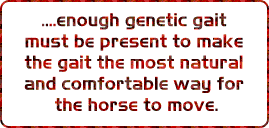
In some gaited breeds, show rules still call for diagonal gaits. In the quest of having horses called "four-gaited" or "five-gaited" the breeder must keep more trotting genes, and unfortunately then there will be a number of these horses that do not gait well at all.
If the breeder also wants his horses to canter well, he will choose more"trotting" genes. The true canter is also a diagonal gait, being produced by the footfall of left rear, right rear and left fore together and then right foreleg. In a run, the gaited horse will do what most suits his genetics. But teaching a show canter or lope means schooling the horse to taking a lead, which in turn hampers the evenness of the four-beat gait.
Some well-gaited horses may have a stage in their lives, especially between six months and 1 1/2 years, when they often trot at liberty. This is not a concern. Gaited horses should be athletic enough to run well. Their gaits should under no circumstances be limited to only a pace (also called a huachano) or a "slick pace" (slightly broken pace).
At the same time, a breed must have a large majority of its individuals that can do a four-beat gait with even timing in order to be considered a gaited breed. A breed that primarily is made up of horses that do a four-beat gait based on a slightly broken diagonal footfall pattern can only be considered "minimally-gaited". A large percentage of offspring from these parents will only trot. Without doubt, breeds of this footfall heritage have been bred for other purposes, at which they may excel. Developing the intermediate gait has been only incidental.
To have a truly well-gaited natural breed, gait must be a top priority among breeders. They must first learn to identify and categorize their horses' gaits, and then select the crosses which will improve the traits they are lacking.
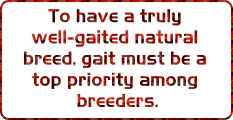 Certain characteristics
may be sought after in one gaited breed and penalized in another.
These modifications of the execution are usually aesthetic but
sometimes they affect function. Examples would be the head
nod in the Tennessee Walker, termino in a Peruvian, and fino-fino
in a Paso Fino. These ways of going would be penalized in a breed
other than the one for which the trait is typical. The Icelandic
Horses keep the trot as a distinct and desirable gait while also
trying to maintain the tolt and flying pace, while a trot
is cause for disqualification in most gaited breed competitions.
The fox-trot is a diagonally-based gait, and the only intermediate
gait some breeds can do, but it is considered unacceptable by
several other gaited breeds.
Certain characteristics
may be sought after in one gaited breed and penalized in another.
These modifications of the execution are usually aesthetic but
sometimes they affect function. Examples would be the head
nod in the Tennessee Walker, termino in a Peruvian, and fino-fino
in a Paso Fino. These ways of going would be penalized in a breed
other than the one for which the trait is typical. The Icelandic
Horses keep the trot as a distinct and desirable gait while also
trying to maintain the tolt and flying pace, while a trot
is cause for disqualification in most gaited breed competitions.
The fox-trot is a diagonally-based gait, and the only intermediate
gait some breeds can do, but it is considered unacceptable by
several other gaited breeds.
Sometimes these characteristics prized by specific breed show
standards are somewhat in conflict with the aim of producing
the very best "travel horse". Judging by function alone,
a trail rider might choose a Tennessee Walking
Horse that did a rack rather than a running walk. The rack could
be smoother and more efficient than the running walk, since the
running walk includes the head nod and accompanying movement
of the croup. The difference is primarily conformational, possibly
related to the length of the femur.
In the same way, an endurance rider would likely choose a Peruvian with little or no termino but great stride, looking for the most efficient covering of ground. A Fox-Trotter that can perform an even four-beat gait may be a more comfortable horse than one that only does the gait for which the breed is named. A Paso Fino that has a show-stopping fino-fino may not move out enough to be a great trail horse, so a rider might choose a largo-gaited horse as a better travel horse. An Icelandic so well-gaited that it tolts at all speeds would be an awesome ride, but would place lower in classes calling for diagonal gaits.
Defining Gait
To make sure we are talking about gaits the same way, we need to use a model to categorize the gaits and their variations. I like to use the chart below, because it shows the continuum of gaits and assigns numbers to each one. Please note that the chart refers only to footfall patterns and not to speeds. Every gait can be performed at a variety of speeds and with many different ways of going, but the primary definition of the gaits is based on the order and timing in which the hooves hit the ground.
| 1 | 25 | 50 | 75 | 100 |
| Trot |
Pasitrote |
Paso Llano |
Sobreandando |
Pace |
| Trote |
Fox-Trot |
Rack |
Andadura |
Huachano |
| Tolt |
Stepping-Pace |
|||
| Running-walk | ||||
| Paso Fino | ||||
| Paso Corto | ||||
| Paso Largo | ||||
| Singlefoot | ||||
| Trocha | ||||
| Marcha Picada | Slick Pace | |||
| Marcha Batida | ||||
Different breeds and individual horses will execute the same gaits but look very different doing so. However, our scale of gait is defined by footfall pattern and not by the way the horse looks while performing that footfall pattern. How he moves his head or lifts his feet doesn't tell us which gait the horse is doing. Think about Jerry Lee Lewis and Liberace playing piano. Both could play the same tunes. The fact that Jerry Lee did it with a "whole lotta shakin"' made no difference to the notes played!
Once we have established the timing of a gait as its primary definition, we can look at execution as a secondary consideration. Head-nod, for example, is used as a secondary definition of a running walk. The same even gait without the head nod would be called a rack. A paso llano and a singlefoot are also isochronal gaits, but in a paso llano there are always three feet on the ground and in a singlefoot there are moments where only one foot is in support. Though all the even gaits can be performed at various speeds, style differences are defined by the breeds to identify show ring preferences.
It is interesting to the breeder to know for certain how fast - or slowly his horse can perform. There is a simple way to check a horse's speed. Mark off a track of eighty-eight feet along a flat, even space. With the horse in a good gait, time it as it travels those 88 feet. If the time is 10 seconds, the horse is going 6 miles per hour. 8.5 seconds equals 7 mph; 7.5 seconds equals 8 mph and 6.7 seconds equals 9 mph. If your horse travels 88 feet in 6 seconds he is going 10 miles per hour.
Slow motion video can help analyze exactly what a horse's footfall sequence and timing is, and therefore what gait he is doing. It is especially valuable with very fast horses whose movements may fool the eye.
Factors Affecting Gait
Because gait is inherited through neurology and affected by conformation means that a horse's gaiting potential can be limited or maximized due to how he is built. Other important factors in the expression of gait are conditioning, training, and temperament.
Temperament is one of the factors most often overlooked in selecting for gait. If a horse is lazy, he will be much harder to collect and drive forward. When asking for a precision gait, collection and balance will be important. A horse with a good natural "motor" will make the most of its genetic gait. A horse that is nervous or excessively high strung, though, will waste too much energy on silliness to be able to perform well. In the Spanish breeds the desirable combination of energy and good sense is called brio. In classes where animation is desired, a horse with more temperament will sparkle. In a performance class such as reining, presence is still an asset but a jumpy horse will not go far.
Conditioning obviously is a factor in any athlete's performance. The more fit the horse becomes, the better it will gait. The exception to this rule would be a horse that naturally has a good even four-beat gait, but is ridden for extended periods out of gait. If a gaited horse is trotted under saddle, it will become a better trotter. If it is galloped, it will get better at taking a lead, which is undesirable in an even four- beat gait. Performing other gaits can build muscle, but ultimately, the only way a horse will improve its gait is by gaiting.
Training to improve gait at its most basic is simply teaching the horse to carry weight and then riding in a way not to interfere with the horse's natural ability. In order to maintain a natural horse, training must not employ any artificial devices. A great horse should be born, not made.
In some breeds, training has become the way gaited horses are made. Training can become an enemy of the breeder when it is difficult to tell how much of the movement of a horse is inborn and how much forced through unnatural methods. The answer to eliminating unnatural training and showing methods -- commonly known as gimmicking -- and to the abhorrent practice of soring that occurs in some breeds, is simply lifetime expulsion for any owner or trainer. This is a penalty that can be an effective deterrent, but due to financial interests some breeds have not yet been successful in making this rule.
Breed registries that have strong rules to protect the naturalness
of their horses have seen a continual increase in popularity.
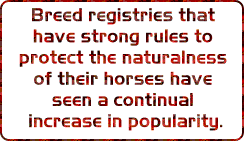 Within the
scope of "natural" training we can include exercises
to supple and flex the horse, and increase muscle development.
Spanish training includes movements that are actually an ancient
form of dressage, and can be valuable in helping a horse find
its best natural gait. For most gaited horses, a trainer's focus
should be placed on improved timing. Once the cadence is even,
the rider can begin to stretch the horse's range in gait -- the
variety of speeds at which the horse maintains a smooth, even
gait. This range is called thread in Peruvian horses.
Within the
scope of "natural" training we can include exercises
to supple and flex the horse, and increase muscle development.
Spanish training includes movements that are actually an ancient
form of dressage, and can be valuable in helping a horse find
its best natural gait. For most gaited horses, a trainer's focus
should be placed on improved timing. Once the cadence is even,
the rider can begin to stretch the horse's range in gait -- the
variety of speeds at which the horse maintains a smooth, even
gait. This range is called thread in Peruvian horses.
One final note on the equitation of a gaited horse: the horse should beexpected to do only that which he can do, naturally. A head held high dueto good conformation and a proud attitude is wonderful to see in a balanced,collected horse. The horse should collect by being allowed to basculeproperly and shift 50% of its weight to its hind limbs. A horse should notbe falsely "collected" by having its head pulled up by the rider's armshauling on the reins and weight placed too far back on the horses loins.This "push-pull" method of riding is very negative in the long-term,resulting in sore horses with diminishing ability.
Showing The Gait
In all breeds, but especially those where only an even four-beat gait is acceptable as a middle gait, the rider must develop a metronome in his head to ensure the gait remains evenly spaced. Many horses can do a very smooth fox-trot (pasitrote) and the rider has a hard time telling what his mount is doing. Typically these horses will trot at slow speeds and begin to gait as they move faster. We also find a number of horses in all of the gaited breeds which are performing practically at a pace. Typically these individuals can do an even gait only at very slow speed and then move to the stepping-pace and then to a pace or close to it, before they have reached an acceptable traveling speed. Some of them can't break the pace without heavy shoes! Placing these horses in high ribbon positions will cause the breed to lose gait ability, as these animals pass on their mediocrity. There are horses so well-gaited they can maintain a pure even four-beat gait up and down hills, on uneven terrain, at slow and fast speeds. These horses drive from the rear, collecting naturally. At speed some even perform the true singlefoot gait: an even four-beat gait with one foot down and three feet up.
When we see the best gaited, most effortless horses in a show ring, we should reward them and help them achieve recognition. Judges can help our breeds' futures by insisting the gaits and execution are natural, functional and not extreme.
We rely heavily on our judges to evaluate a breed's progress. As we train and accredit judges we set the stage for the future of the breed. As we promote gaited horses, All-Gaited Shows will become increasingly important. Sometimes in these shows judges are asked to place breeds with which they are not particularly familiar. Judges' exchange programs and seminars for judges of all the gaited breeds would be helpful to train a pool of knowledgeable people who know gait and can judge these open gaited shows wisely.
Breeding For Better Gait
Several of the well-known gaited breeds are losing their genetic ability to gait with every generation. To reverse this trend and breed for better gait, we need to start with at least one parent with superb natural timing and smoothness. If a mare lacks gait but has other wonderful qualities, breed her to a stallion truly exceptional in gait. If a mare has truly wonderful gait but is deficient in other areas, she should be bred to the best-gaited stallion available that can correct her faults.
It is highly inadvisable to breed together two animals that tend to trot or two animals that tend to pace. The preferred method is to breed to the ideal. Failing that, at least we should not cross two horses that will compound each other's shortcomings.
Should we use ever stallions that lack a good natural gait?
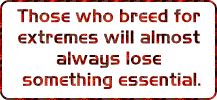 Maybe, but sparingly,
and only if they are exceptional in other areas. Our show judging
standards can assist this process by placing sufficient emphasis
on gait in the breeding division classes. There are many champion
stallions that are never entered in gait classes, because they
would not win a high placing. Each gaited breed can decide how
best to emphasize gait to encourage improvement.
Maybe, but sparingly,
and only if they are exceptional in other areas. Our show judging
standards can assist this process by placing sufficient emphasis
on gait in the breeding division classes. There are many champion
stallions that are never entered in gait classes, because they
would not win a high placing. Each gaited breed can decide how
best to emphasize gait to encourage improvement.
It is really critical while breeding toward ideals, to avoid extremes. Those who breed for extremes will almost always lose something essential. An example would be breeding for high knee action. Lift increases naturally in a loose, well-gaited horse as he extends his gait. But to breed for lift for its own sake will result in horses that are rough and can't reach in a natural way.
Peruvian Horse Gait Specifics
In the Peruvian Paso, the ideal horse can do a paso llano at a variety of speeds and also perform a sobreandando at a variety of speeds. In addition, the horse will be smooth in both gaits at all speeds and also exhibit overstep in all gaits, even a slight amount in the paso llano. Is this a high standard of gait? Undoubtedly. Is it too high a standard? I don't think so even though the number of horses that meet it is small.
Since the Peruvian breed puts great emphasis on gait, its shows offer classes judged solely on gait. Major shows crown a Best Gaited Horse of Show, to reward and recognize this essential breed characteristic. The standard must be high to maintain and improve the breed's reputation as the pinacle of perfection in gaited horses. The only way to maintain the depth of breed ("hondura de raza") is to judge to a strict standard and reward horses that meet the standard naturally.
To meet the admittedly high standard of Peruvian gait, we need to breed for horses that have smoothness, wonderful timing, advance, overstep, thread and balance. In a paso llano, overstep will be limited to capping in some horses, with half a print over being superior, a whole print even better, and six inches overstep in the isochronal gait being truly outstanding. More overstep is not better than the correct amount.
Advance is sometimes confused with overstep. Advance is the distance a horse moves forward during one full stride cycle. Usually good overstep and good advance are found in the same horse, and horses lacking one will usually lack the other. However, there are rare horses with minimal overstep that will advance well.
As a horse moves from a paso llano to a sobreandando (closer to the pace), the overstep will increase. Therefore a horse that only caps at a paso llano should show overstep in a sobreandando. A horse with overstep at the paso llano will ususally have an execution called gateado (cat-like) and will have excellent overstep in a sobreandando.
Some breeders and even judges mistake a slow sobreandando with a paso llano gateado. This confusion could come from concentrating on harmony -- something a good Peruvian horse should show in his execution -- meaning that his knees and hocks should appear to be tied together with an invisible rod (like the wheels of a train). This can be deceiving and good judges listen carefully to the timing of the gait and learn not to mistake a pacey horse with one that has correct harmony and timing. Looseness will be a good clue as to whether a horse is performing properly. Tight horses are never gateado, no matter their timing.
If a horse can only do a sobreandando when beyond the speed of a walk, and barely caps while doing this, it is not a well-gaited Peruvian horse, no matter how smooth it may be. There are well-gaited horses that perform most of the time at a sobreandando, but they have a broad thread and all the other characteristics good gait requires. If judges reward tight, pacey horses, the breed will suffer. If they reward pacey horses with little or no overstep, Peruvian horses will lose gait with every generation.
The Peruvian horse must be judged at a slow speed. They need to demonstrate the depth of their breeding ("hondura de raza") by traveling in an even gait at the speed of 5 or 6 miles per hour. They should also be shown at a natural walk on a loose rein, briefly, in every class. But once horses have been categorized initially at a slow speed, they should also be allowed to demonstrate their thread ("hilo"). Excessive speed is not necessary, but maintaining a pure gait in a range of speeds is certainly a virtue. Sometimes it seems that in an effort to help people understand how important it is that Peruvians gait slowly, we have created the idea that any horse that can also gait fast is not well-gaited. Nothing could be further from the truth. The best-gaited Peruvian horses in the past decades have all been capable of 10 or 12 mph -- or more -- in a good gait, at full extension. But all of them were made to prove themselves in the show ring at the slower speeds.
Evaluating gait is a multi-step process. An experienced breeder or judge may be able to accomplish all the steps in a matter of moments, whereas a novice may need time to take in each aspect separately.
The very first step is to eliminate all horses with pasterns that drop below horizontal during normal forward movement. The second step is to choose the smoothest horses in the group. Then, pick the horses that are reaching the rear hoof underneath the rider. This can be done by drawing a line vertically from the point of the hoof where it hits the ground. The better-gaited horses will meet this test, whereas with horses of lesser quality the line will fall under the back of the saddle near the crupper buckle. (This test is one of the few ways to evaluate a horse in a still photo for quality of movement, but the photo must show the horse directly from the side.)
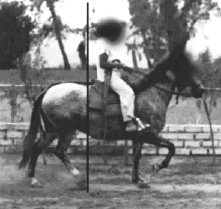 This horse falls short of ideal. |
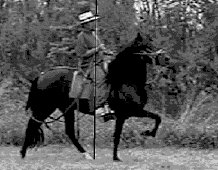 This horse meets the test. |
Once we have established a group of horses that are strong, smooth, have advance, we would look at timing and overstep together. Horses with even four-beat timing, and overstep, can move to the head of the class. Horses that land with a heavier sound in front hooves than in the rear are put in lower categories. Then the final step is to put the horses in the order you have decided to place them, and then check thread. A good way is to ask the first place horse to go as slowly as possible in a good gait, and check how the other horses maintain their gaits and cadence. Then the lead horse would be asked to go a little faster, and a little faster, to demonstrate thread. A judge often shifts a place or two at this point, putting horses with limited range into the lower ribbons.
Shaping the Future
The market for gaited horses is expanding tremendously. The driving force behind this expansion is promotion by enthusiastic owners riding getting their horses out in the public eye. The pleasure horse market is a very important niche, and will be key to expansion for smooth-gaited horses.
When someone rides a gaited horse for the first time, they often realize they have discovered what a horse should be. To the average rider, the smooth ride is enough, and many enjoy their horse without studying the fine points of the gait.
Breeders have to think a little differently. After all, they are shaping the future of our horses. For hundreds of years the world's horsemen have known gaited horses. In fact for ages there were more gaited horses than trotters. As we enter the 21st century we are not inventing something new; we are attempting to recover and preserve a genetic entity that is danger of being lost. This is a serious responsibility. Breeders need to study gait and observe how it is transmitted from generation to generation. Only then can he reliably produce the horses to satisfy trail riders, show enthusiasts and the breeders of the future.
Return to Pasos
on the Web!
This page was placed February 26,
2000
Page updated November 6, 2005